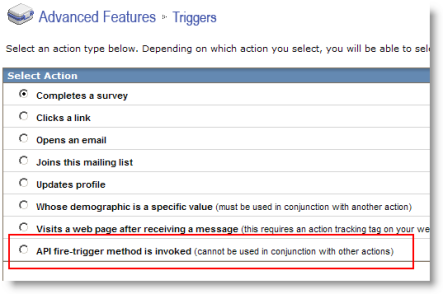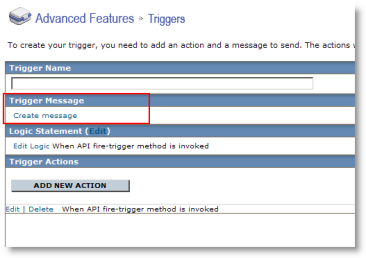


Transactional messages result from a significant or unusual event in a customer’s life; e.g., . a purchase, a larger than normal bank deposit, birthday, graduation, marriage, Web site visit, or direct email conversation with a company. Typically, you would send a transactional `(or event-based) message immediately after an event occurs, but you can also sequence them at strategically-timed intervals. Purchase notifications, payment and shipping status, renewal reminders, and special offers are all examples of transactional messaging.
The EmailLabs Transactional API trigger is designed for users who know of a transaction on their Web site. It allows them to specify a recipient of the message, the envelope information, and the message itself and route that information through the EmailLabs transactional processers. By doing this they are taking advantage of EmailLabs’ advanced reporting and deliverability.



Activity: FIRE-TRIGGER
Transfers data to EmailLabs to enable a transactional message to be sent from the system. Must be paired with a trigger stub in the EmailLabs application. See help manual for full implementation.
Functional Description
Trigger_id[required]
Tells the system which trigger stub to use for reporting and default message (if using)
Recipients[requiredl]
Comma delimited list of email address to receive email. Can be one address or many.
Recipients_data[optional]
Location of CSV or TXT file with large list of recipients. Must be in URL format (http://example.com/data.csv)
Subject[optional]
Subject of the message if not using the default specified in the user interface.
From_email[optional]
From email address to use in the message envelope if not using the default specified in the user interface.
From_name[optional]
YYYY-MM-DD - Limits the results to this end date
Tracking[optional]
Enabled open and click tracking for the message (if not using the default message specified in the user interface)
Message[optional]
URL of location to fetch HTML content or actual raw HTML (URL encoded).
| Parameter | Req? | Type | ID |
Value |
| Site_ID | Yes | N/A | N/A | (Site ID of account) |
| MLID | Yes | N/A | N/A | (Mailing list ID of trigger) |
| trigger_ID | Yes | Extra | trigger_ID | (id of trigger) |
| recipients | No | Extra | recipients | (single or comma delimited list of recipients) |
| recipient_data | No | Extra | recipient_data | (URL location of CSV file with recipients) |
| subject | No | Extra | subject | (Subject Line) |
| from_email | No | Extra | from_email | (From Email Address) |
| from_name | No | Extra | from_name | (From Name) |
| tracking | No | Extra | tracking | on |
| message content | Yes | Extra | message | URL of location to fetch html or full HTML |
EXAMPLE
Type=triggersfdd
Activity = fire-trigger
Input=
<DATASET>
<SITE_ID>123</SITE_ID>
<MLID>345</MLID>
<DATA type="extra" id="trigger_id">123</DATA>
<DATA type="extra" id="recipients">alice@example.com,bob@example.com</DATA>
<DATA type="extra" id="recipients_data">http://example.com/data.csv</DATA>
<DATA type="extra" id="subject">Subject</DATA>
<DATA type="extra" id="from_email">reply@lyris.com</DATA>
<DATA type="extra" id="from_name">Lyris</DATA>
<DATA type="extra" id="tracking">on</DATA>
<DATA type="extra" id="message">http://example.com/message.html</DATA>
</DATASET>
NOTE: You can utilize the default message in the trigger if you choose. Simply send only the trigger ID and the recipient information.
NOTE: You can send a single recipient or a comma delimited list of recipients. You can also send a CSV file of recipients via a web location.
NOTE: You can use personalization inside the message being sent along, simply use the existing mail merge tags or dynamic content.